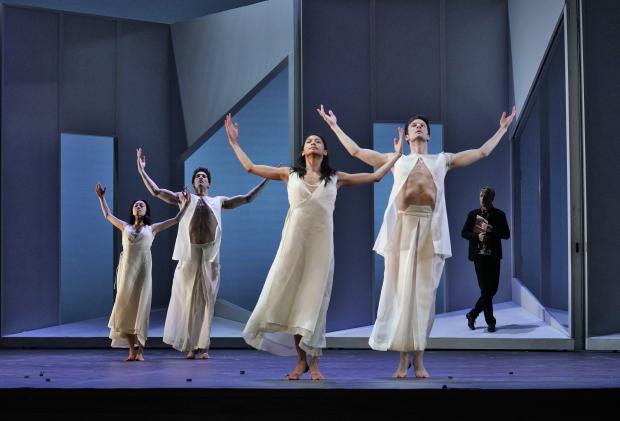How ironic that Orpheus and Eurydice, an opera about hell, has one of the most exquisite expressions of paradise ever to grace the stage. According to The Victor Book of Operas by Louis Biancolli and Robert Bagar, O&E has “the classic, serene beauty that one associates with Grecian art.” That’s largely because composer Christoph Willibald von Gluck and librettist Pierre-Louis Moline derived the storyline for their 1774 opera from the ancient Greek myth of Orpheus’ (Russian tenor Maxim Mironov) descent into the Underworld to rescue his deceased beloved, Eurydice (Louisianan soprano Lisette Oropesa) and attempt to bring her back to life. Orpheus, but of course, was the son of Apollo and Calliope, the gods of music and poetry, and a chip off the ol’ Olympian block, he was antiquity’s peerless musician.
During his odyssey to Hades, Our Man Orpheus encounters the monstrous Cerberus (who in this show looks a bit like the gill-man in The Shape of Water) and the hellish Furies. The intrepid Orpheus stumbles across “The Happy Valley” of Elysium, idyllically articulated by the Joffrey Ballet, which joined forces with LA Opera and Lyric Opera of Chicago to present this production of O&E, beautifully choreographed, directed and designed by John Neumeier of the Hamburg Ballet (which will provide O&E’s dancers once this version pirouettes across the Atlantic to Germany).
The Joffrey’s hoofers are simply sensuous delights to behold, enchanting “Spirits of the Blessed” that visualize a utopian ambiance with their “Dance of the Happy Shades.” At times this production is as much a ballet as it is an opera. O&E’s costumes, sets, lighting and sonorous music, too, is often enchanting, with Grant Gershon lightly conducting LA Opera Chorus’ altos, tenors and basses. At times a harp enhances the heavenly mood. James Conlon conducts Gluck’s at times hauntingly lovely music.
It’s no wonder that when Orpheus arrives to pluck Eurydice back to the land of the living, she’s resistant. This production and the supertitles didn’t make it clear that the Greek gods had forbidden Orpheus from looking directly back at his wife, but this causes her to question the depths of his love - even though he had, like, just risked life and limb, fighting his way through Hades to find and rescue his willful, headstrong wife. The mythic source for this story is full of doubt about the love between partners and perhaps the plot could be summed up as: “She loves me, She loves me not, She loves me, She loves me not,” ad infinitum.
I believe Orpheus’ friend/muse Amor - which of course, translates as “Love” - was originally meant to be a male character, but here Amor is played by a female (Minnesotan soprano Liv Redpath, a Domingo-Colburn-Stein Young Artist with LA Opera) in “mannish” duds. Maybe this is a reference to gender fluidity?
There are other changes from the 1774 version - which has had significant alterations over the centuries. The opera was actually first produced in Vienna with an Italian libretto by Raniero de’ Calzabigi in 1762 but the music and libretto were changed for the Paris iteration in 1774, with a libretto in French by Moline. Hector Berlioz got into the act in the 19th century and the rendition now onstage at the Dorothy Chandler has changed Orpheus from a musician per se into a choreographer and dance instructor, while Eurydice is the company’s moody prima ballerina and diva par excellence. As you’ll also quickly see, ancient Greece has morphed into the post-Henry Ford era.
I’ve written before about how 21st century productions of Greek myths forsake togas and the mythic milieu of yore for “modern” retellings. But if contemporary companies want to lose the togas, why don’t they just create and invent their own brand new sagas with original characters, instead of repurposing stories created long ago by long-dead authors who can’t protect their creations and intellectual property rights. I suspect this has something to do with brand identity - and how hard it is for artistic usurpers to create their own iconic dramatis personae and tales. (To be fair, some of the ballet dancers’ costumes designed by Neumeier are toga-ish, although at the end some of the men’s outfits reminded me of Kirk Douglas in Spartacus and I kept waiting for Tony Curtis to shout “I’m Spartacus!”)
Having said this, it was a beatific experience to see the Joffrey, that fabled ballet company, perform. Living in a gun-drenched society filled with Glocks, we could use more Gluck. Neumeier’s direction is at times inspired - he uses cinematic techniques such as fade outs and perhaps split screens, with some clever stagecraft, special effects and deceptively simple sets. The utopian, enchanting, ethereal vision of Elysium elicits a transcendentally sublime trance. In these troubled times, we can’t ever get enough of that. See it with someone you love - but preferably a partner who’s still alive.
Orpheus and Eurydice will be performed March 15, 21 and 24 at 7:30 p.m. and March 18 and 25 at 2:00 p.m. at L.A. Opera at the Dorothy Chandler Pavilion, 135 N. Grand Ave., Los Angeles, CA 90012. See: https://www.laopera.org/season/1718-Season/orpheus/.

